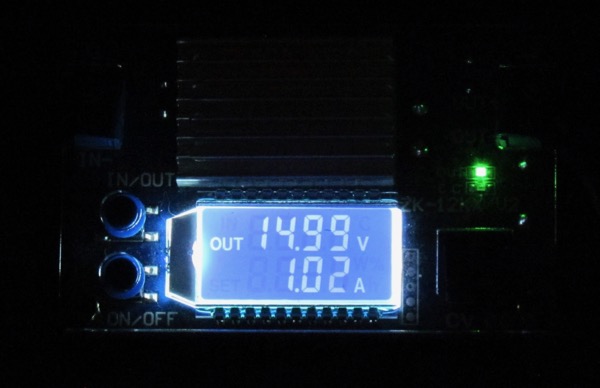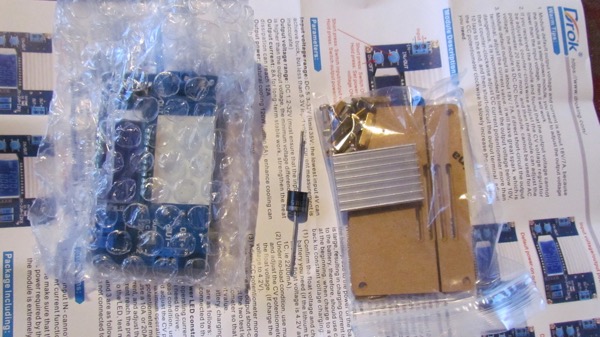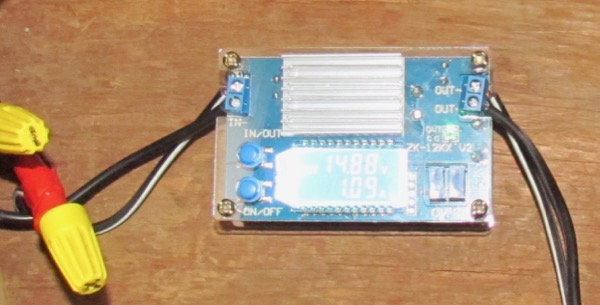I spoke in the previous post of an adjustment to our off-the-grid power system:
If you go back and read blog follower comments on our posts, you may be familiar with Ekij. In response to our post, LED Light Update, he suggested adding a DC-DC converter to our system to save wear and tear on our DC system as it tries to utilize the higher voltage of our nickel-iron (Ni-Fe) battery. He suggested this one as an example (paid link); I ordered it, and it seems to work well.

Here it is again in the dark, so you can see the readout better. I’ve since adjusted the step down more, to about 13 volts (Photo: Mark A. Zeiger).
Basically, and hopefully briefly, the battery, as I’ve discussed previously, operates at higher voltage than a lead-acid battery bank does. When we installed the new battery, we needed a new inverter that operated at higher voltage without cutting out at higher voltage (most commonly, 15.5 volts)(see A New Inverter for the Cabin).
Our DC outlets seemed to adapt to the higher voltage, although we’ve observed a few symptoms of overpowering. Most notably and inconveniently, the lights in the on/off switches of the outlet sets burned out fairly early on (see New 12 Volt Outlets for the Cabin).
The answer came in a device I’d never heard of until Ekij introduced to me: a DC-DC converter. It takes in the full voltage of the battery, and steps it down to a user-settable lower voltage.
I assembled the unit when it arrived, and installed it, unfortunately during our lower power period. I wasn’t able to test its effectiveness until the wind returned, pushing our battery’s voltage level back up above 16 volts. When that happened, we saw that it worked like a charm!
True, we now have an additional step to turning off our system at night. If we fail to push the little button that turns the outflow power off, the unit draws small but significant amp hours of power from our battery overnight. It has become a new phantom load on our system (see The Hidden Cost of Convenience: Phantom Loads) that we mitigate a bit by turning it off. Come summer, with long hours of sunshine, we likely won’t bother with this step, but in the winter, it’s a small issue.
A small issue. The benefits far outweigh the drawback.

Here’s how it arrived, complete with ESL Chinese-to-English instructions. The diode is not mentioned in the instructions (which did not include assembly!) which I find slightly troubling, but so far, it doesn’t appear essential for our application (Photo: Mark A. Zeiger).
In particular, we replaced our little Bestek inverter (see Review: The Bestek 300 Watt Power Inverter), which had been handy for small AC needs until it burned out (probably because of the higher voltage of the “new” battery). We have hardly found opportunity to use the replacement, as it cuts out at 15.5 volts, but now that we have the DC-DC converter, we can use the inverter to run our Christmas lights, both outside the cabin, and inside, on the Christmas tree and elsewhere.
As I’ve noted before, Christmas lights are essential to our holiday. So in a sense, we’ve received a wonderful, early Christmas gift from Ekij. He not only gave us his expertise, but he generously contributed more than the cost of the unit to us. We are very grateful for this, and remember him every time we turn the Christmas lights on! Of course, this gift will continue to keep giving far beyond the Christmas season, as we power our computers and cell phones more safely, among many other electrical devices in our homestead.


Glad it’s working for you.
Can you elaborate on the diode (even by email if you don’t want to do it in the comments).From the pic it looks like a good chunky ~6A diode you have there.
Sometimes these are included in Dc-DC converters intended to be wired such that if the supply is cut, but there is capacitance on the load side that the load Voltage doesn’t hold higher than the supply as some DC-DC chips don’t like that (can be damaged). By having the diode such that it feeds from the load side (out) to the supply side (in) it’s normally reverse biased and does nothing but when the supply side is disconnected it ensures that the supply side never sees less than load-0.7V.
(Of course it could also be included for some totally different reason!)
Ekij, you definitely got me. I’ll email off site for guidance. Thanks!